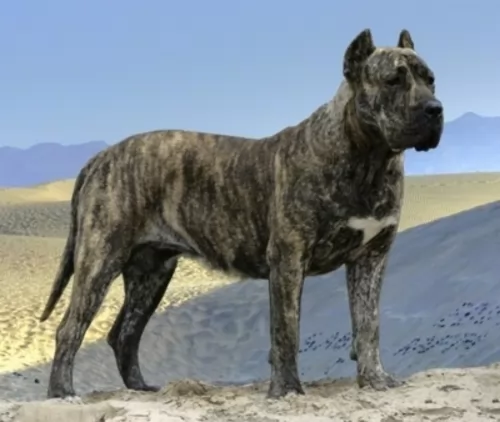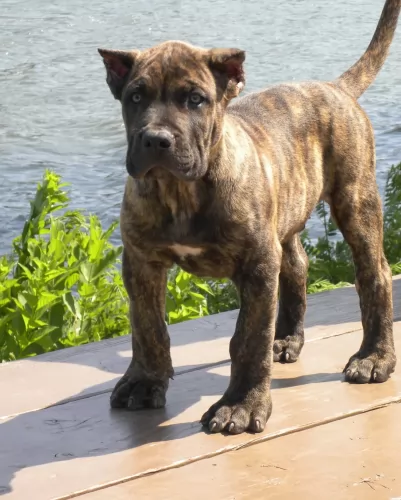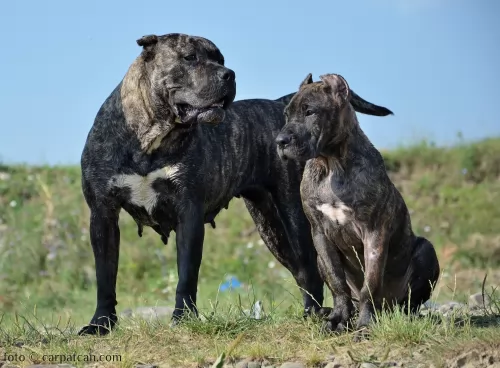 Petzlover
Petzlover American Eskimo Dog is originated from United States but Presa Canario is originated from Spain. American Eskimo Dog may grow 17 cm / 6 inches shorter than Presa Canario. American Eskimo Dog may weigh 44 kg / 97 pounds lesser than Presa Canario. American Eskimo Dog may live 4 years more than Presa Canario. American Eskimo Dog may have less litter size than Presa Canario. American Eskimo Dog requires High Maintenance. But Presa Canario requires Low Maintenance
American Eskimo Dog is originated from United States but Presa Canario is originated from Spain. American Eskimo Dog may grow 17 cm / 6 inches shorter than Presa Canario. American Eskimo Dog may weigh 44 kg / 97 pounds lesser than Presa Canario. American Eskimo Dog may live 4 years more than Presa Canario. American Eskimo Dog may have less litter size than Presa Canario. American Eskimo Dog requires High Maintenance. But Presa Canario requires Low Maintenance
 The American Eskimo is derived from the Nordic Spitz breed and most closely related to the German Spitz in particular. There were many German Spitzes in the United States at the time of the second World War and anti-German sentiment caused its name to change to the American Eskimo Dog. However, as the breed developed over time in the States, the American Eskimo became its own separate breed. In addition to the German Spitz, the American Eskimo is also related to the white Keeshond, the Samoyed, the white Italian Spitz and the white Pomeranian.
The history is beginning to show that the Spitzes that were brought to the US in the early 1900’s was white. This color was not popular in Europe but was quickly the favorite in the United States. They were originally working dogs on farms and ranches. They have excellent herding instincts, make goo watch and guard dogs, and good law enforcement sniff dogs. However, their first introduction to the American public was through the Cooper Brothers’ Railroad Circus and Stout’s Pal Pierre at the Barnum and Baily Circus. Eskimo puppies were sold after the circus show.
The American Eskimo is derived from the Nordic Spitz breed and most closely related to the German Spitz in particular. There were many German Spitzes in the United States at the time of the second World War and anti-German sentiment caused its name to change to the American Eskimo Dog. However, as the breed developed over time in the States, the American Eskimo became its own separate breed. In addition to the German Spitz, the American Eskimo is also related to the white Keeshond, the Samoyed, the white Italian Spitz and the white Pomeranian.
The history is beginning to show that the Spitzes that were brought to the US in the early 1900’s was white. This color was not popular in Europe but was quickly the favorite in the United States. They were originally working dogs on farms and ranches. They have excellent herding instincts, make goo watch and guard dogs, and good law enforcement sniff dogs. However, their first introduction to the American public was through the Cooper Brothers’ Railroad Circus and Stout’s Pal Pierre at the Barnum and Baily Circus. Eskimo puppies were sold after the circus show.
It was then that the breed became one of America’s favorite breeds and they quickly became house pets. Following World War II, Japan exported the Japanese Spitz into America and it was crossed with the Eskimo also. The American Eskimo Dog breed was not recognized by AKC until 1985. Still in 1958 there was no official breed club in the States but there were growing numbers of the dogs. It was not until 1970 did the National American Eskimo Dog Association (NAEDA) come into being. They collected the pedigrees of the first 1750 dogs to be AKC registered.
Since the American Eskimo Dog is not recognized internationally, those wishing to participate in international competition such as England’s prestigious Cruft’s Dog Show must register their dogs a German Spitz. Despite this the American Eskimo and German Spitz remain two very different breeds.
 Known also as the Canary Mastiff, the Presa Canario hails from the Canary Islands. He was originally bred for guarding livestock.
Known also as the Canary Mastiff, the Presa Canario hails from the Canary Islands. He was originally bred for guarding livestock.
This isn’t a new breed by any means, and it is believed that the dog dates back to the 15th and 16th centuries. The roots of the dog can be traced back to the Iberian Presa, a medium sized mastiff breed. A number of other Hispanic breeds have contributed to the formation of the Presa Canario, such as the Presa Espanol.
Its numbers have dropped over the years, but in the 1970s, reputable breeders bred Presa Canarios, a courageous, territorial dog.
Because of its aggressive tendencies, the dog has been banned from quite a few countries. It is found in the USA but not recognized by the American Kennel Club.
 This small to medium dog is beautiful and resembles a miniature Samoyed. There are three sizes of American Eskimo – the standard, miniature, and the toy. The Eskimo’s head is wedge shaped with tall, triangular, erect ears. It has a heavily plumed tail with a sharp curl over the back. The Eskimo can burst into bold action due to their good legs and feet.
This small to medium dog is beautiful and resembles a miniature Samoyed. There are three sizes of American Eskimo – the standard, miniature, and the toy. The Eskimo’s head is wedge shaped with tall, triangular, erect ears. It has a heavily plumed tail with a sharp curl over the back. The Eskimo can burst into bold action due to their good legs and feet.
The coat is a double one with a harsh outer coat and plush inner one. The coat is always white or white with cream or biscuit markings, and visible skin in gray or pink. The American Eskimo’s ruff or mane is very heavy, and the nose, eyelids, pads and gums are black. They have dark eyes and blue are not allowed.
 The Presa Canario is a large Molosser-type dog breed originally bred for working livestock.He stands at between 56 to 65cm in height and weighs between 38 and 60kg. He has a thick, muscular body with a black mask over the broad head.
The Presa Canario is a large Molosser-type dog breed originally bred for working livestock.He stands at between 56 to 65cm in height and weighs between 38 and 60kg. He has a thick, muscular body with a black mask over the broad head.
The ears were always cropped which just added to his aggressive appearance. When left they are high set and floppy, being of medium length. The coat is short and coarse and he is a low shedder. The coat comes in colors such as fawn, tan, or brindle.
Strong willed, confident and determined, the Presa Canario may well have an intimidating look.He looks both powerful and even a bit aggressive, but with training and socialization, the highly intelligent Presa Canario is actually a calm, docile dog, totally loyal and loving with his human family.
These dogs are suspicious of strangers and this makes them excellent watchdogs. For new dog owners, the Presa Canario isn’t a good first choice as he is strong-willed and can be aggressive when in the wrong hands. There are however, always exceptions, but he isn't considered to be a good choice of dog when there are children in the home.
 The Eskimo is affectionate, playful and love children of all ages. They are intelligent and want to please you. They can be trained easily and are champions of the obedience trial. They are fun and confident. At the same time, they need a confident pack leader. He is prone to Little Dog Syndrome where the dog thinks they oversee the home and display all sorts of behaviors. Under these circumstances the American Eskimo can become obsessive, aggressive, and engaging in obsessive resource guarding and barking.
The Eskimo is affectionate, playful and love children of all ages. They are intelligent and want to please you. They can be trained easily and are champions of the obedience trial. They are fun and confident. At the same time, they need a confident pack leader. He is prone to Little Dog Syndrome where the dog thinks they oversee the home and display all sorts of behaviors. Under these circumstances the American Eskimo can become obsessive, aggressive, and engaging in obsessive resource guarding and barking.
 The Presa Canario is a formidable looking dog and has received quite a lot of negative media attention for being aggressive and dangerous. And yet non-aggressive owners who have brought the dog up properly tell of how well mannered and calm their dogs are.
The Presa Canario is a formidable looking dog and has received quite a lot of negative media attention for being aggressive and dangerous. And yet non-aggressive owners who have brought the dog up properly tell of how well mannered and calm their dogs are.
The dog is confident and powerful and can be loyal and loving while also being well adjusted. Just like children are the fruit of their parents upbringing, so dogs turn out much the same as the kind of owners that reared them, and in the right hands, this big dog can be loyal quiet, loving and trustworthy.
 The American Eskimo Dog is prone to hip dysplasia. Their eyes and tear ducts are potential issues with progressive retinal atrophy. They are allergic to fleas and have a tendency to be overweight.
The American Eskimo Dog is prone to hip dysplasia. Their eyes and tear ducts are potential issues with progressive retinal atrophy. They are allergic to fleas and have a tendency to be overweight.
We deal with PRA (Progressive Retinal Atrophy) in greater detain in a following section but it is not as destructive as it used to be. It is much more treatable now.
There are potentially some dental issues that some American Eskimo Dogs are prone to.
 These are large dogs so they are susceptible to hip- or joint dysplasia and canine leishmaniasis.
These are large dogs so they are susceptible to hip- or joint dysplasia and canine leishmaniasis.
This is a skeletal condition, found more often in large dogs. The ball and socket don’t fit properly, grinding as opposed to sliding smoothly. This eventually leads to loss of function of the joint.
There are a few factors that lead to the development of hip dysplasia in dogs, but it is also hereditary. That is why it is so important to provide your dog with the correct nutrition – one that is specially formulated for large breeds.
This is a deadly disease caused by a protozoan parasite found in dogs, mostly in rural areas, and in quite a few areas of the world.
The parasite is transmitted by a sand fly. The clinical signs of dogs with this disease include weakness, fever, swollen lymph nodes, anorexia, weight loss and diarrhea with blood in the stools.
Treatment will require the administration of a special drug. Prognosis for a pet diagnosed with Leishmaniasis is unfortunately not very hopeful.
 Your American Eskimo Dog needs a high quality food so they will not get overweight. Make sure you know how much is appropriate for your particular dog and her specific age. The puppies should be fed twice a day but adults only once.
Your American Eskimo Dog needs a high quality food so they will not get overweight. Make sure you know how much is appropriate for your particular dog and her specific age. The puppies should be fed twice a day but adults only once.
As previously mentioned the American Eskimo Dog is prone to eye issue such as Progressive Retinal Atrophy or (PRA) – this disease is inherited and used to cause blindness as the rods in the retina died. New medical discoveries mean this is no longer a hopeless disease. Their eyes are also susceptible to other issues so make sure you check them and the tear ducts regularly.
Like so many other breeds the American Eskimo is also susceptible to hip dysplasia and a moving patella in the knee. For this reason watch their weight. They can also be very allergic.
This small dog has more energy than his size can handle. He needs a lot of exercise and a place to run. If he will become hyperactive and destructive. They are prone to disturbing behaviors such as spinning (spinning in circles) when they don’t get enough exercise. The American Eskimo Dog is smart and agile, Play games like catch or agility. They are also great at herding, competitive obedience or detection.
 The Presa Canario will require being brushed twice a week to rid him of loose hair although he isn’t a heavy shedder.
The Presa Canario will require being brushed twice a week to rid him of loose hair although he isn’t a heavy shedder.
Keep his nails trimmed.
Check inside his ears for signs of redness and the possibility of an ear infection.
When you brush him, check him over for any unusual lumps.
Make sure the dog is neutered or spayed if you don’t want puppies.
Get your vet to the vet if he shows signs of illness.
Make sure his vaccines are up to date to prevent some deadly canine diseases.
Ensure he has a nice comfortable, dry, warm place to sleep.
Ensure he has a top quality diet to enhance longevity and health. Commercially manufactured dog foods are a convenient means to feed your pet, and there are some excellent brands. Avoid the ones with low quality ingredients that don’t have the right balances of vitamins and minerals.
High quality dry kibble can become exciting when you add in some home-made food. Dogs thrive on simplicity, so boiled chicken, sweet potatoes, brown rice or pasta, carrots and spinach will be 100% sufficient for him. Chop this food up and add it into the dry kibble twice a week as a tasty treat.
Also, your pet will thrive on a bit of raw meat added in from time to time. Make sure he is never without a constant supply of fresh, cool water.
Make sure that your large pet gets a good quota of daily exercise outdoors. Lots of hectic ball- and rope games will keep him happy and keep him slim. Take him for a walk every day.